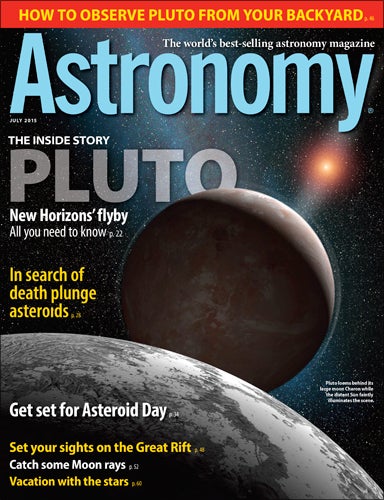Video FAQ page
Stern has been at the forefront of efforts to visit Pluto for nearly three decades, and he traces the many discoveries that pushed Pluto to its place as a giant in the kingdom of the dwarfs. The story also features the incredible illustrations of Ron Miller, whose official Pluto postage stamp is attached to the spacecraft.
To preview all New Horizons’ historic encounter will offer, pick up the July issue of Astronomy magazine, on newsstands June 2.
Hunt the last planet
As Pluto comes to prominence in the public psyche, the far-off world will also reach its brightest place in the night sky. Astronomy Senior Editor Richard Talcott guides backyard observers to the dim dot as Pluto reaches opposition on July 6. Fittingly, the best views come in the week around New Horizons’ Pluto flyby during New Moon.
In search of death plunge asteroids
In an alternate world envisioned by famed physicist and asteroid hunter Mark Boslough, astronomers could have prepared all night for the Chelyabinsk fireball that hit Russia in 2013. In July’s issue, the astronomer imagines the science and safety that could be achieved by finding space rocks before they strike. Apollo 9 astronaut Rusty Schweickart joins Boslough in his call for planetary defense with a column aptly titled “In defense of Earth.”
Vacation with the stars
Summer hits its stride in July, and veteran observer Tom Trusock has readers covered with some great astronomer travel ideas. From an ancient city aligned with the heavens in Chaco Canyon, New Mexico, to California’s Mount Wilson Observatory, home to the largest telescopes in the world devoted solely to public viewing, there’s a vacation opportunity to suite all interests and budgets.
July sky events visible without optical aid
- July 1 — Jupiter and brilliant Venus stand side by side at twilight.
- July 9 — Venus gleams at its best in Northern Hemisphere evening skies.
- July 30 — The Southern Delta Aquariid meteor shower peaks.
Also in the July 2015 Astronomy
- “Set your sights on the Great Rift”: This unrelenting chain of dark nebulae is mightily impressive when you know what to look for.
- “The nature of observing”: Want to see the Orion Nebula’s hidden colors? First, take a walk outside to watch flowers in the moonlight.
- “Get set for Asteroid Day”: On June 30, 2015, Asteroid Day will mark a milestone in awareness of the dangers of near-Earth asteroids.
- “Catch some Moon rays”: Turn your scope toward a crater, crank up the power, and hope for illumination.
- “Go light with the Star Adventurer mount”: Sky-Watcher USA’s mount is small, light, and accurate — plus it wont’ break the bank.
- “The Sky this Month”: Exclusive star charts will guide you through July’s night sky.
- The July issue also features Snapshot, Astro News, Ask Astro, Bob Berman’s Strange Universe, Jeff Hester’s For Your Consideration, Glenn Chaple’s Observing Basics, Stephen James O’Meara’s Secret Sky, Adam Block’s Cosmic Imaging, Erika Rix’s Astro Sketching, New Products, Letters, Web Talk, Reader Gallery, and Breakthrough.
Astronomy offers you the most exciting, visually stunning, thorough, and timely coverage of the heavens above. Each monthly issue includes expert science reporting, vivid color photography, complete sky-event coverage, spot-on observing tips, informative equipment reviews, and more. All of this comes in an easy-to-understand user-friendly style that’s perfect for astronomers at any level. Contact Astronomy, the world’s best-selling astronomy magazine, at 262.796.8776 or email editor@astronomy.com.










